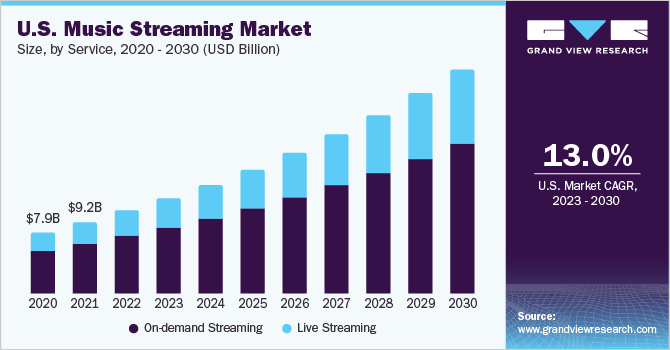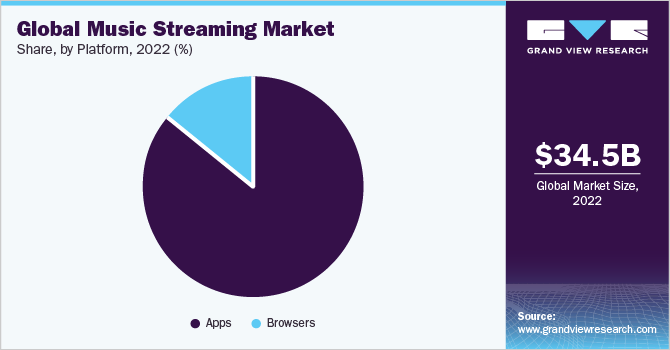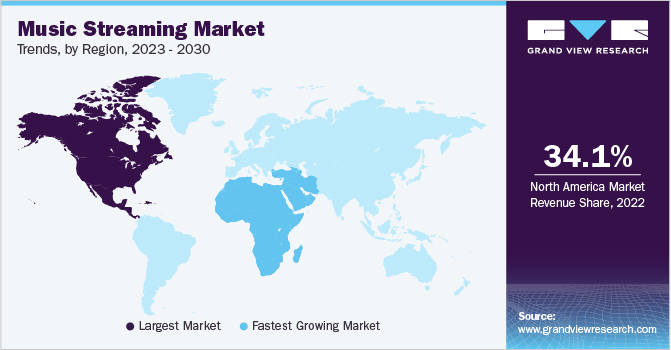- Home
- »
- Next Generation Technologies
- »
-
Music Streaming Market Size & Share Analysis Report, 2030GVR Report cover
![Music Streaming Market Size, Share & Trends Report]()
Music Streaming Market Size, Share & Trends Analysis Report By Service (On-demand Streaming, Live Streaming), By Platform (Apps, Browsers), By End-use (Commercial, Individual), By Content Type, By Region, And Segment Forecasts, 2023 - 2030
- Report ID: GVR-4-68039-218-0
- Number of Report Pages: 130
- Format: PDF, Horizon Databook
- Historical Range: 2018 - 2021
- Forecast Period: 2023 - 2030
- Industry: Technology
Report Overview
The global music streaming market size was estimated at USD 34.53 billion in 2022 and is expected to grow at a compound annual growth rate (CAGR) of 14.4% from 2023 to 2030.The growing adoption of digital platforms and the widespread utilization of smart devices is expected to drive market expansion over the forecast period. The popularity of music streaming services, which include websites that allow users to see music videos and listen to podcasts along with audio files, is rising considerably, owing to the attractive features offered, which include personalized song recommendations, automatic playlist customization, and seamless accessibility across various applications and web browsers.

The rising adoption of 5G connectivity has also emerged as a prominent trend in the global market. Following this trend, the key players in the market started new music services that offer music streams and downloads for music enthusiasts. With 5G technology becoming more prevalent, along with the significant speed and data transmission capabilities of 5G over 4G, the companies can provide high-quality music streams. These advancements in technologies and connectivity are further driving the market growth. Moreover, the implementation of technologies, such as Artificial Intelligence (AI) and Machine Learning (ML), enhances the streaming experience of music by improving search recommendations.
For instance, in January 2022, Gamma Gaana Ltd., an Indian music application, launched a new feature in their application that uses AI to improve music suggestions and enhance user experience. Such strategies by companies are expected to fuel market growth over the forecast period. The COVID-19 pandemic has created lucrative growth opportunities for the market. The pandemic has led to increased subscribers on music streaming platforms, such as Tencent Music Entertainment, Spotify, and Amazon Music, among others. Moreover, with people staying at home due to lockdowns and social distancing measures, there has been a surge in demand for music.
Individuals turned to streaming platforms to discover and enjoy music, resulting in increased user engagement and longer listening sessions, leading to the growth of the market. Moreover, music streaming companies are focused on offering music video streaming, song lyrics, and podcasts on their platforms to improve customer experience. For instance, in November 2022, Amazon.com, Inc.’s subsidiary company, Amazon Music, expanded its prime membership benefit by offering a full catalog of music with over 100 million songs and their top podcasts ad-free. Such types of developments by industry players are expected to drive the market demand over the forecast period.
Service Insights
The on-demand streaming segment accounted for the largest revenue share of 70.8% in 2022 and is expected to dominate the market over the forecast period. The advent of on-demand streaming services has significantly restricted unauthorized music streaming and downloading across the board, benefiting stakeholders ranging from distributors to musicians. Furthermore, these services enhance customer convenience by providing discovery functionalities and personalized recommendations tailored to individual preferences, driving segment growth.
The live streaming segment is expected to register the fastest CAGR of 15.7% over the forecast period owing to the increasing popularity of live videos that has encouraged artists to stream live on social media websites, such as Instagram, YouTube Live, Twitter, and Facebook Periscope. The rising trend of live streaming in the music industry has emerged as a significant promotional tool for artists, enabling them to effectively exhibit their skills, promote an enthusiastic fan base, and gather exposure to fresh audiences, augmenting segment growth.
Content Type Insights
The audio segment accounted for the largest revenue share of 61.8% in 2022 and is expected to continue the trend over the forecast period. The growth is attributed to its convenience in catering to the multitasking tendencies of listeners, as it enables users to engage in various activities, such as exercising, commuting, or performing household chores that require audio content to provide a seamless and convenient entertainment experience.
The video segment is expected to grow at the fastest CAGR of 15.4% over the forecast period. The growing demand for Over-the-Top (OTT) platforms globally serves as one of the key factors for the video segment growth. Consumers’ growing preference for OTT platforms, which provide convenient and on-demand access to a wide range of video content, is augmenting segment growth. Moreover, the utilization of OTT platforms for live performances and video streaming is expected to propel the segment's growth.
End-use Insights
The individual segment accounted for the largest revenue share of 63.2% in 2022 and is expected to continue the same trend over the forecast period. This is attributed to the changing lifestyles of the younger generations, who embrace the habit of incorporating music into their daily routines. Moreover, with the increasing availability of wireless networks and the rising penetration of mobile devices, the individual end-use segment is also expected to grow over the forecast period.
The commercial segment is expected to grow at the fastest CAGR of 15.7% over the forecast period. The growth of the segment, which includes restaurants, cafeterias, salons, and gyms, among others, is attributed to the utilization of data and analytics tools within the music streaming market as data generated by these tools offer businesses valuable insights regarding popular tracks, customer behavior, and engagement levels. This data-driven approach enables businesses to make informed decisions about their music selections and overall customer experience, which is driving the commercial segment growth.
Platform Insights
The application segment accounted for the largest revenue share of 86.4% in 2022 owing to the preference for easy accessibility with apps over browsers and numerous features that enhance the overall user experience while streaming music. Some of its key features include customizable playlists, high-quality audio streaming, offline playback, social sharing options, and integration with other applications and devices. Such features are expected to augment the segment growth over the forecast period.

The browser segment is expected to register a considerable growth rate of around 10% over the forecast period. This is attributed to the widespread availability of internet connectivity and the increasing reliance on web browsers for several activities that include browser-based music streaming. In addition, leveraging the cloud-based infrastructure, the browser can offer users an extensive music library, tailored recommendations, and seamless synchronization of playlists and preferences across multiple devices, which is expected to fuel the demand for the browser segment.
Regional Insights
North America accounted for the largest revenue share of 34.1% in 2022 and is anticipated to witness considerable growth over the forecast period. A significant factor driving the market growth in this region is the presence of key market players, such as Pandora Media, Inc., Amazon.com, Inc., Google LLC, and Apple, Inc. Furthermore, the availability of fixed wireless internet, smart devices, and online payment technologies is contributing to the growth of the regional market.

Middle East & Africa is anticipated to emerge as the fastest-growing regional market with a CAGR of 17.5% from 2023 to 2030. The rising trend of smartphone adoption and increasing internet penetration in the region have played a major role in driving the growth of the market. Moreover, users have gained a convenient and portable means to access music streaming platforms in the form of smartphones. This trend has significantly contributed to the market’s expansion.
Key Companies & Market Share Insights
The market is classified as highly competitive with the presence of several key players that focus on strategic alliances, mergers & acquisitions, expansions, and product developments to remain competitive in the industry. For instance, in May 2023, Google LLC launched MusicLM, an AI-based model that can generate high-fidelity music with the help of text. This technology can convert a series of written descriptions into a cohesive musical story or narrative, utilizing existing melodies, whether they are communicated through whistling, humming, singing, or instrumental playing. Such initiatives by key players are anticipated to augment the market growth over the forecast period. Some prominent players in the global music streaming market:
-
Spotify AB
-
Apple, Inc.
-
Amazon.com, Inc.
-
Google LLC
-
Deezer SA
-
Pandora Media, Inc.
-
Tencent Music Entertainment Group
-
Tidal
-
SoundCloud Global Limited & Co. KG
-
iHeartMedia, Inc.
Music Streaming Market Report Scope
Report Attribute
Details
Market size value in 2023
USD 40.20 billion
Revenue forecast in 2030
USD 103.07 billion
Growth rate
CAGR of 14.4% from 2023 to 2030
Base year for estimation
2022
Historical data
2018 - 2021
Forecast period
2023 - 2030
Report updated
July 2023
Quantitative units
Revenue in USD billion, and CAGR from 2023 to 2030
Report coverage
Revenue forecast, company ranking, competitive landscape, growth factors, and trends
Segments covered
Service, platform, content type, end-use, region
Regional scope
North America; Europe; Asia Pacific; Latin America; Middle East & Africa
Country scope
U.S.; Canada; Germany; UK; France; Italy; Spain; China; India; Japan; South Korea; Brazil; Mexico; South Africa; UAE
Key companies profiled
Apple, Inc.; Amazon.com, Inc.; Google LLC; Spotify AB; Deezer; Pandora Media, Inc.; Tencent Music Entertainment Group; SoundCloud Global Limited & Co. KG; iHeartMedia, Inc.
Customization scope
Free report customization (equivalent to up to 8 analyst working days) with purchase. Addition or alteration to country, regional & segment scope
Pricing and purchase options
Avail customized purchase options to meet your exact research needs. Explore purchase options
Global Music Streaming Market Report Segmentation
This report forecasts revenue growth and provides an analysis of the latest trends in each of the sub-segments from 2018 to 2030. For this study, Grand View Research has segmented the global music streaming market report based on service, platform, content type, end-use, and region:
-
Service Outlook (Revenue, USD Billion, 2018 - 2030)
-
On-demand Streaming
-
Live Streaming
-
-
Platform Outlook (Revenue, USD Billion, 2018 - 2030)
-
Apps
-
Browsers
-
-
Content Type Outlook (Revenue, USD Billion, 2018 - 2030)
-
Audio
-
Video
-
-
End-use Outlook (Revenue, USD Billion, 2018 - 2030)
-
Individual
-
Commercial
-
-
Regional Outlook (Revenue, USD Billion, 2018 - 2030)
-
North America
-
U.S.
-
Canada
-
-
Europe
-
UK
-
Germany
-
France
-
Italy
-
Spain
-
-
Asia Pacific
-
China
-
Japan
-
India
-
South Korea
-
-
Latin America
-
Brazil
-
Mexico
-
-
Middle East & Africa (MEA)
-
South Africa
-
UAE
-
-
Frequently Asked Questions About This Report
b. The global music streaming market size was estimated at USD 34.53 billion in 2022 and is expected to reach USD 40.20 billion in 2023.
b. The global music streaming market is expected to grow at a compound annual growth rate of 14.4% from 2023 to 2030 to reach USD 103.07 billion by 2030.
b. Some key players operating in the music streaming market include Spotify AB, Apple, Inc., Amazon.com, Inc., Google LLC, Deezer, Pandora Media, Inc., and Tencent Music Entertainment Group.
b. North America dominated the music streaming market with a share of over 34% in 2022. This is attributable to the rising adoption of music streaming mobile applications integrated with state-of-the-art technologies for a better consumer experience.
b. Key factors that are driving the music streaming market growth include the growing adoption of digital music services, the rise in online content consumption, and technological advancements in the music streaming industry.
Share this report with your colleague or friend.
![gvr icn]()
NEED A CUSTOM REPORT?
We can customize every report - free of charge - including purchasing stand-alone sections or country-level reports, as well as offer affordable discounts for start-ups & universities. Contact us now
![Certified Icon]()
We are GDPR and CCPA compliant! Your transaction & personal information is safe and secure. For more details, please read our privacy policy.
We are committed towards customer satisfaction, and quality service.
"The quality of research they have done for us has been excellent."





